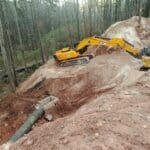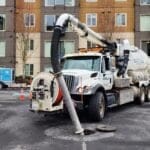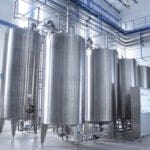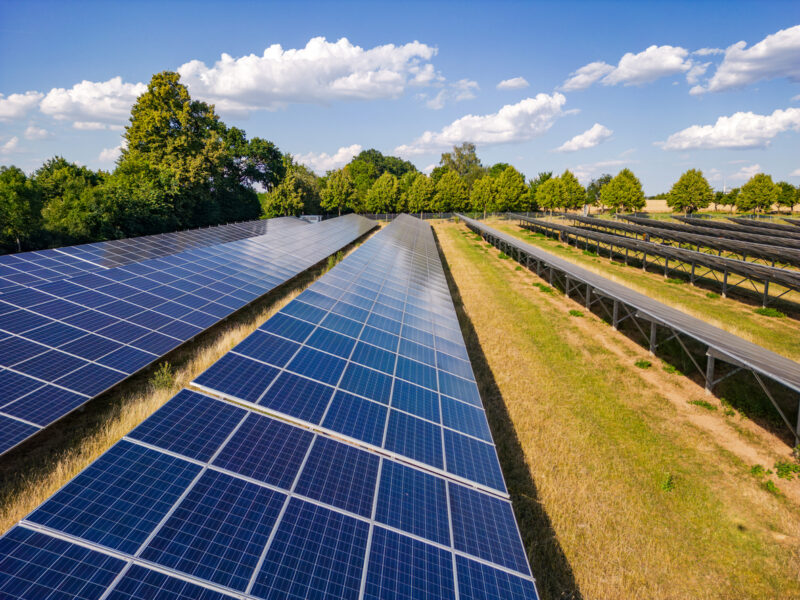Managing Runoff on Solar Farms
By: Jason Abert, VP Program Development & Partnerships
As regulations and grants emerge centered around solar farms, understanding their impact on stormwater is crucial. Solar farms describe the photovoltaic (PV) technology of solar panels, also called cells, installed across fields. As opposed to traditional commercial solar panels, the land used for solar farms is repurposed farmland, a practice called agrivoltaics. The structures can be installed semi-permanently, with the intention of removal in 30 years [Bay Journal]. Currently, there are no federal regulations set for solar farm stormwater management. Stormwater management for solar farms follows the National Pollutant Discharge Elimination System (NPDES) permit requirements for land disturbance of an acre or more.
States have varied approaches to solar-specific guidance around managing stormwater at these farms. Research is divided on whether it is best to classify the space as pervious or impervious, dependent upon potential infiltration of stormwater. In Minnesota, for example, solar panels are classified as a disconnected impervious surface. The panels themselves are impervious material, but as stormwater flows off, it is discharged to a pervious surface, vegetation below, where infiltration can occur.
There has been debate on how the hydrology of the existing land is affected when solar panels are installed. The US Department of Energy (DOE) funded a research study to determine water quality on solar farms. Through the study, researchers have found best practices that produce an estimated 38% less runoff than the previous method; the Natural Resources Conservation Service runoff curve [PV SMaRT]. The Best Practices: Photovoltaic Stormwater Management Research and Testing (PV-SMaRT) analysis highlights four key elements in reducing stormwater runoff from solar farms.
The first element that affects water quality on PV farms is soil compaction. There is potential soil compaction from heavy machinery required to install the cells and maintain the surrounding vegetation. This compaction can negatively impact infiltration rates. Reducing the heavy machinery on a site or tilling the soil afterwards ensures stormwater can infiltrate the soil.
Another key factor in water quality on solar farms is the depth of the soil. Deeper soil allows for further stormwater penetration and also more established vegetation. Stormwater is absorbed into vegetation and can reach groundwater through root systems. Deeper root systems encourage the infiltration process. Soil depth is also the least adaptable component of PV water quality as it is difficult to add depth. Sites with more shallow soils can improve water quality by widening the space between cells to allow more time for infiltration [PV SMaRT].
Vegetation itself is another element in improving water quality. Like all stormwater best management practices, vegetation is essential to improving water quality. Plants absorb many pollutants like nitrogen, for their growth. As the stormwater hits the cells and drains, it is concentrated and can potentially have energy ten times greater than typical rainfall, significantly impacting the ground below [Hydrologic Response]. In the event vegetation on these farms fail, stormwater will erode the land, causing sediment and pollutants to continue downstream.
Finally, the orientation and spacing of the panels also affect the natural evapotranspiration process as the space between cells must be wide enough to allow sunlight to reach the vegetation below. Some solar farms use gravel below panels rather than vegetation as it decreases maintenance. In these instances, additional stormwater control measures must be implemented as stormwater runoff cannot be controlled by gravel alone.
These four key elements work together to improve water quality on solar farms. Intentionally structuring a solar farm around these key elements ensures success of stormwater management on your site. While these practices are the most widely accepted for determining runoff from solar farms, PV SMaRT is not the expected regulation of a federal level. Depending on your local ordinances, additional stormwater management practices may be required.
Vegetation chosen for solar farms should be incorporated intentionally to withstand both direct sun and shade. Native vegetation is encouraged as it is more likely to thrive in local climate conditions [Earth’s Future]. Many solar farms also incorporate pollinator friendly vegetation to encourage a habitat. As with all vegetation surrounding stormwater management, there is little to no need for pesticides and herbicides. Vegetation naturally collects the excess nutrients present in runoff, and through natural processes converts the nutrients into energy. Minimal mowing is recommended as heavy machinery compacts the soil, limiting the root systems of the vegetation. Some studies recommend incorporating goats or sheep to manage excessive growth of vegetation and avoid compaction from mowing [Bay Journal].
If you have additional questions about managing stormwater on solar farms, request a FREE consultation now. As the national water compliance provider with a local presence, AQUALIS understands local regulations and how to maintain compliance.
Sources:
Bay Journal
PV SMaRT pdf
Hydraulic Response of Solar Farms pdf
Earth’s Future pdf

 Kenosha, Wis. Highway KR Regenerative Stormwater ConveyanceThe Root-Pike Watershed Initiative Network Kenosha County, and others worked with AQUALIS to design and implement an innovative solution for stormwater control along Highway KR.
Kenosha, Wis. Highway KR Regenerative Stormwater ConveyanceThe Root-Pike Watershed Initiative Network Kenosha County, and others worked with AQUALIS to design and implement an innovative solution for stormwater control along Highway KR. Durham, N.C. Sinkhole Leads to Stormwater System RehabilitationThe tenant on this property noticed a depression that opened to the ground below and notified the property owners.
Durham, N.C. Sinkhole Leads to Stormwater System RehabilitationThe tenant on this property noticed a depression that opened to the ground below and notified the property owners.


